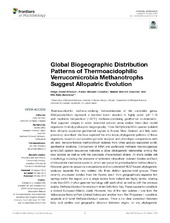| dc.contributor.author | Erikstad, Helge Andre | |
| dc.contributor.author | Ceballos, Ruben Michael | |
| dc.contributor.author | Smestad, Natalie Bennett | |
| dc.contributor.author | Birkeland, Nils-Kåre | |
| dc.date.accessioned | 2020-03-23T14:02:45Z | |
| dc.date.available | 2020-03-23T14:02:45Z | |
| dc.date.issued | 2019 | |
| dc.Published | Erikstad HA, Ceballos, Smestad NB, Birkeland NK. Global Biogeographic Distribution Patterns of Thermoacidophilic Verrucomicrobia Methanotrophs Suggest Allopatric Evolution. Frontiers in Microbiology. 2019;10:1129 | eng |
| dc.identifier.issn | 1664-302X | en_US |
| dc.identifier.uri | http://hdl.handle.net/1956/21572 | |
| dc.description.abstract | Thermoacidophilic methane-oxidizing Verrucomicrobia of the candidate genus Methylacidiphilum represent a bacterial taxon adapted to highly acidic (pH 1–4) and moderate temperature (∼65∘C) methane-containing geothermal environments. Their apparent ubiquity in acidic terrestrial volcanic areas makes them ideal model organisms to study prokaryotic biogeography. Three Methylacidiphilum species isolated from distantly-separated geothermal regions in Russia, New Zealand, and Italy were previously described. We have explored the intra-taxon phylogenetic patterns of these organisms based on comparative genome analyses and phenotypic comparisons with six new Verrucomicrobia methanotroph isolates from other globally-separated acidic geothermal locations. Comparison of rRNA and particulate methane monooxygenase (pmoCAB) operon sequences indicates a close phylogenetic relationship among the new isolates as well as with the previously characterized strains. All share similar cell morphology including the presence of extensive intracellular inclusion bodies and lack of intracellular membrane systems, which are typical for proteobacterial methanotrophs. However, genome sequence comparisons and concatenated MLST-based phylogenetic analyses separate the new isolates into three distinct species-level groups. Three recently processed isolates from the Azores (each from geographically-separate hot springs within the region) and a single isolate from Iceland are highly similar, sharing more than 88% in silico genome homology with each other as well as with the previous isolate, Methylacidiphilum fumariolicum strain SolV, from Italy. These appear to constitute a distinct European/Atlantic clade. However, two of the new isolates – one from the Yellowstone National Park (United States) and another from The Philippines – constitute separate and novel Methylacidiphilum species. There is no clear correlation between fatty acid profiles and geographic distance between origins, or any phylogenetic relationship. Serological analysis using antiserum raised against M. kamchatkense strain Kam1 revealed large differences in the degree of cross-reactivity with no correlation with other factors. However, the genetic distance between the strains does correlate to the distance between their geographic origins and suggests a global biogeographic pattern shaped by an isolation-by-distance mechanism. These results further confirm terrestrial geothermal springs as isolated islands featuring allopatric prokaryotic speciation. | en_US |
| dc.language.iso | eng | eng |
| dc.publisher | Frontiers | en_US |
| dc.rights | Attribution CC BY | eng |
| dc.rights.uri | http://creativecommons.org/licenses/by/4.0 | eng |
| dc.title | Global Biogeographic Distribution Patterns of Thermoacidophilic Verrucomicrobia Methanotrophs Suggest Allopatric Evolution | en_US |
| dc.type | Peer reviewed | |
| dc.type | Journal article | |
| dc.date.updated | 2019-12-30T09:32:01Z | |
| dc.description.version | publishedVersion | en_US |
| dc.rights.holder | Copyright 2019 The Author(s) | en_US |
| dc.identifier.doi | https://doi.org/10.3389/fmicb.2019.01129 | |
| dc.identifier.cristin | 1718137 | |
| dc.source.journal | Frontiers in Microbiology | |

